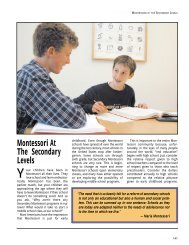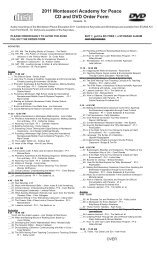Tim Seldin & Paul Epstein Ph.D. An Education for Life
Tim Seldin & Paul Epstein Ph.D. An Education for Life
Tim Seldin & Paul Epstein Ph.D. An Education for Life
Create successful ePaper yourself
Turn your PDF publications into a flip-book with our unique Google optimized e-Paper software.
Finding the Right School<br />
“Why is there so much variation<br />
from one Montessori<br />
school to another? How can I<br />
know if I’ve found a ‘real’<br />
Montessori school?”<br />
Although most schools try to<br />
remain faithful to their understanding<br />
of Dr. Montessori’s<br />
insights and research, they have all<br />
been influenced by the evolution of<br />
our culture and technology. Remember,<br />
despite the impression many parents<br />
hold, the name Montessori refers<br />
to a method and philosophy, and it is<br />
neither a name protected by copyright<br />
nor a central licensing or franchising<br />
program.<br />
In many parts of the world, anyone<br />
could, in theory, open a school and<br />
call it Montessori with no knowledge<br />
of how an authentic program is organized<br />
or run. When this happens, it is<br />
both disturbing and embarrassing <strong>for</strong><br />
those of us who know the difference.<br />
Many of these schools fail but often<br />
not be<strong>for</strong>e they harm the public’s perception<br />
of the integrity and effectiveness<br />
of Montessori as a whole.<br />
Often, one sign of a school’s commitment<br />
to professional excellence<br />
is their membership in one of the<br />
professional Montessori societies,<br />
such as the Association Montessori<br />
Internationale or the American Montessori<br />
Society. They, along with several<br />
other Montessori organizations,<br />
such as the International Montessori<br />
Council, also offer schools the opportunity<br />
to become accredited as<br />
well.<br />
There are many other smaller Montessori<br />
organizations as well, but the<br />
key is to remember that there is no<br />
requirement that a Montessori school<br />
be affiliated or accredited by any outside<br />
organization. Quite a few<br />
Montessori schools choose to remain<br />
independent.<br />
What should we look <strong>for</strong> when<br />
we visit Montessori schools?<br />
The Montessori Learning Environment<br />
▲ Montessori classrooms should be<br />
bright, warm, and inviting, filled<br />
with plants, animals, art, music,<br />
and books. Interest centers will be<br />
filled with intriguing learning<br />
materials, mathematical models,<br />
maps, charts, international and<br />
historical artifacts, a class library,<br />
an art area, a small natural-science<br />
museum, and animals that the<br />
children are raising. In an elementary<br />
class, you will also normally<br />
find computers and scientific<br />
apparatus.<br />
▲ You should not find rows of desks<br />
in a Montessori classroom. There<br />
will not be a teacher’s desk and<br />
chalk board in the front of the<br />
room. The environment will be<br />
set up to facilitate student discussion<br />
and stimulate collaborative<br />
learning.<br />
FINDING THE RIGHT SCHOOL<br />
▲ Montessori classrooms will be<br />
organized into several curriculum<br />
areas, usually including: language<br />
arts (reading, literature, grammar,<br />
creative writing, spelling, and<br />
handwriting); mathematics and<br />
geometry; everyday living skills;<br />
sensory-awareness exercises and<br />
puzzles; geography, history, science,<br />
art, music, and movement.<br />
Most rooms will include a classroom<br />
library. Each area will be<br />
made up of one or more shelf<br />
units, cabinets, and display tables<br />
with a wide variety of materials on<br />
open display, ready <strong>for</strong> use as the<br />
children select them.<br />
▲ Students will typically be found<br />
scattered around the classroom,<br />
working alone or with one or two<br />
others.<br />
▲ Teachers will normally be found<br />
working with one or two children<br />
at a time, advising, presenting a<br />
new lesson, or quietly observing<br />
the class at work.<br />
237




